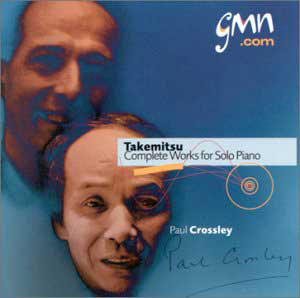Toru Takemitsu is Japan’s finest composer of western
music. His friend Paul Crossley, who has already magnificently recorded
the excellent Quotation of Dream with the London Sinfonietta, is perhaps
the pre-eminent pianist for his music. Ideal conditions for a five-star
disc then? Well, it hasn’t quite worked out like that. Or maybe the
excellent portents show up some of the weaknesses of Takemitsu’s music?
To put it bluntly, there is a lot of chaff amongst his wheat, and only
some of the Complete Works are of compelling interest.
Just as English readers lose their critical faculties
just because a haiku has seventeen syllables, some western listeners
have fawned over Takemitsu’s music because of its calm and tranquillity,
which is considered uniquely Zen. But much of the piano music is extremely
similar to that of Messiaen, in particular his Preludes, and I am not
so sure Takemitsu is as rigorous, or as imaginative as his role model.
The finest pieces – the Rain Tree Sketch or Les Yeux Clos (both of which,
a trifle indulgently, exist in two versions) – have a very limpid beauty.
Surprisingly, considering the quality of the orchestral works, the piano
works’ lack of obvious organisation leaves me at least with no path
into it, and much of it appears similar, and at its worst, dreary.
Nevertheless there is plenty to enjoy in this recording,
thanks to the excellent advocacy of Paul Crossley. In music as static
as this the colours become all important, and Crossley does marvels
creating the different effects evoked by the score. Anyone interested
in this music can be sure that the performances are first rate. But
having listened to them I am no wiser as to the point of this music.
Why is one note accented within a chord and not any other? Are the patterns
really as arbitrary as they seem? Cool and calm it may be, and often
extremely beautiful, but I cannot discern what it is trying to achieve.
I fear that it is not a reputation that will last.
Aidan Twomey


